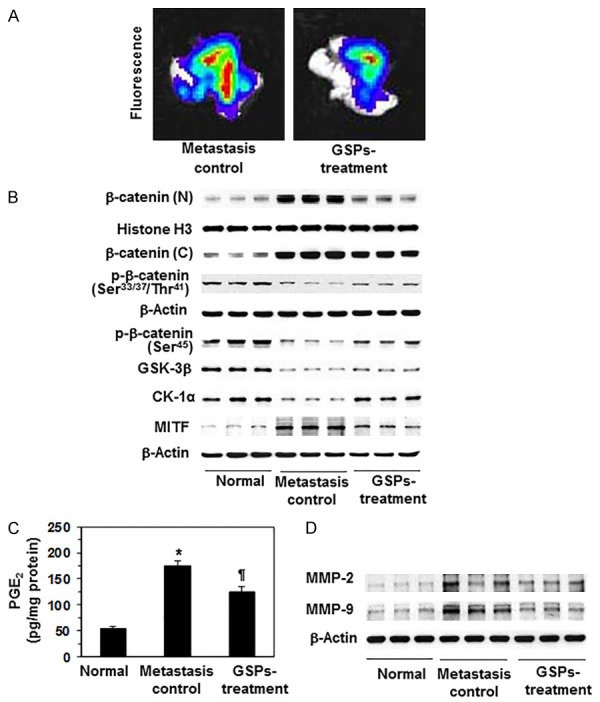Figure 7.

Effect of dietary administration of GSPs on melanoma cells invasion in vivo in athymic nude mice and associated proteins of β-catenin signaling molecules in internal body organ, such as lung. A. Mice were injected through the tail vein with A375 melanoma cells (2.5×106/mouse) constitutively expressing luciferase and EGFP. GSPs was given to mice in diet after supplementation with AIN76A control diet, as detailed in Materials and methods, n = 6/group. Seven weeks after melanoma cell injection, mice were sacrificed, and lungs were harvested as a target organ and subjected to bioluminescence imaging for the detection of melanoma cells using Xenogen IVIS200 imaging system. Red color indicates higher or intense accumulation or density of melanoma cells. B. Administration of dietary GSPs inhibits the cytosolic and nuclear levels of β-catenin, and MITF protein in lungs compared to the lungs from the non-GSPs-treated group of control mice, whereas the levels of p-β-catenin, GSK-3β and CK-1α were elevated or restored. Western blot data are shown in triplicate/group. Each sample was prepared from the pooled lung tissues from 2 animals. C. Dietary GSPs reduce the levels of PGE2 in lungs compared to the lungs from the control mice. PGE2 analysis in lung tissue samples was done using the Cayman PGE2 Enzyme Immunoassay Kit (Ann Arbor, MI) following the manufacturer’s instructions. D. GSPs decrease the levels of MMP-2 and MMP-9 in lungs compared to the lungs from the non-GSPs-treated control mice. At the termination of the experiment, lungs were harvested and lysates were prepared for the analysis of MMPs using western blot analysis, n = 6. Significant elevation of PGE2 (*P<0.001) compared to normal lung samples, while significant inhibition (¶P<0.01) versus metastasis-specific control group.
